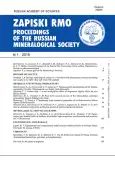Experimental and computational model of pyrite-sphalerite-barite assemblage formation under the mixing of fluids
- Autores: Laptev Y.V.1
-
Afiliações:
- Sobolev Institute of Geology and Mineralogy, Siberian Branch RAS
- Edição: Volume 148, Nº 1 (2019)
- Páginas: 117-125
- Seção: ЭКСПЕРИМЕНТАЛЬНАЯ МИНЕРАЛОГИЯ
- URL: https://journals.eco-vector.com/0869-6055/article/view/11306
- DOI: https://doi.org/10.30695/zrmo/2019.1481.09
- ID: 11306
Citar
Texto integral
Resumo
Experimental and thermodynamic study of the formation conditions of sulfates and sulfides under the mixing of fluids has been carried. This geochemical process is very important for modern sulfide ore formation at the floor of the oceans. Experimental procedure was based on the scheme H2S (H2SO4) + МеСl2 → MeS (MeSO4) + 2HCl. During experiments, sphalerite and pyrite, together with barite, were synthesized by mixing aquatic solutions of chloride of zinc, iron, and barium with sulfide-containing solutions at temperature of 200—275 °C and pressure of 100 bar. Experimental data on the composition of fluid and solid phases were used to validate a computational model. To calculate the composition of non-ideal solid solution of sphalerite (ZnS-FeS), the Margules asymmetric model was applied. Contents of iron in sphalerite calculated through this model and determined from experiments at 243 °С are 1.5 and 1.0 wt % correspondingly. The good similarity of these values indicates the feasibility of the proposed model of deep-sea sulfide ore formation in ocean floor structures.
Palavras-chave
Texto integral
Sobre autores
Yu. Laptev
Sobolev Institute of Geology and Mineralogy, Siberian Branch RAS
Autor responsável pela correspondência
Email: laptev@igm.nsc.ru
Rússia, Novosibirsk
Bibliografia
- Bogdanov Y. A., Lisitsyn A. P., Sagalevich A. M., Gurvich E. G. Hydrothermal ore genesis of the ocean floor. Moscow: Science, 2006. 527 p. (in Russian).
- Barton P. B., Skinner B. J. Stability of sulfide minerals. In: Geochemistry of hydrothermal ore deposits. Ed. Barnes, H. L. New York: Holt, Rinehart and Winston, Inc., 1967. P. 236-333.
- Barton P. B., jr., Toulmin P. III. Phase relations involving sphalerite in the Fe-Zn-S system. Econ. Geol. 1966. Vol. 61. N 5. P. 815-849.
- Grichuk D. V. Thermodynamic models of submarine hydrothermal systems. Moscow: Scientific World, 2000. 304 p. (in Russian).
- Delgado J., Soler A. An integrated thermodynamic mixing model for sphalerite geobarometry from 300 to 850 °C and up to 1 GPa. Geochim. Cosmochim. Acta. 2005. Vol. 69. N 4. P. 995-1006.
- Laptev Yu. V. Computer reconstruction of the physicochemical conditions of sulfide formation for the Krasnov and Ashadze hydrothermal systems. Russian Geol. Geophys. 2015. Vol. 56. P. 865-874.
- Laptev Y. V., Shvarov Yu. V. Computer simulation in hydrothermal systems with allowance for nonideality of sphalerite and pyrrhotite. Geol. Ore Deposits. 2012. Vol. 54. N 4. P. 304-312.
- Maslennikova S. P., Maslennikov V. V. Paleozoic «black smokers» sulfide chimneys (after the example of Urals). Ekaterinburg: UB RAS, 2007. 312 p. (in Russian).
- Vikentiev I. V. Formation and metamorphism of volcanic-associated sulfide deposits. Moscow: Scientific World, 2004. 344 p. (in Russian).
- Shvarov Yu. V. HCh: New potentialities for the thermodynamic simulation of geochemical systems offered by Windows. Geochem. Int. 2008. Vol. 46. N 8. P. 898-903.
- Tivey M. K. The influence of hydrothermal fluid composition and advection rates on black smoker chimney mineralogy: Insights from modeling transport and reaction. Geochim. Cosmochim. Acta. 1995. Vol. 59. N 10. P. 1933-1949.
- Tivey M. K., McDuff R. E. Mineral precipitation in the walls of black smoker chimney: a quantitative model of transport and chemical reaction. J. Geophys. Res. 1990. Vol. 95. P. 12 617-12 637.
Arquivos suplementares










